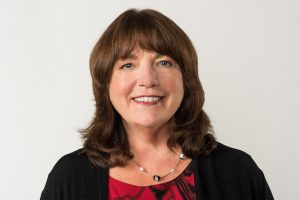Along the Caregiving Journey
In our first interview for our 2019 caregiving series, Real World Health Care spoke with Susan Reinhard, RN, PhD, FAAN, senior vice president and director of AARP’s Public Policy Institute and chief strategist, Center to Champion Nursing in America.
We talked with Dr. Reinhard about the many challenges facing people who are caring for loved ones with chronic illness and how AARP can help them along their journey as a caregiver.
Real World Health Care: AARP is well known as an organization that empowers people to choose how they live as they age. How does that mission extend to people caring for a loved one with a chronic illness such as multiple sclerosis, cancer or Parkinson’s disease?

Susan Reinhard, AARP
Susan Reinhard: Our mission at AARP is to help family caregivers by giving them what they need, when they need it and where they need it. The journey is different for every individual caregiver and every individual loved one, and it can change over the trajectory of an illness.
Acting as a family caregiver for someone with a chronic, long-term condition may be a completely different experience than caring for a loved one with an acute condition like a heart attack, stroke, or even cancer – all of which are shocking but are treatable. On the more chronic end of the disease spectrum, consider Parkinson’s disease, a progressive disease that a person can live with for 20 or 30 years. Diseases like Parkinson’s, as well as MS, are typically difficult to diagnose and lead to many questions about how to treat the disease, how living with the disease will impact the person’s life and how to navigate the health care system.
Caregiving is not a one-fits-all-and-at-all-times role. AARP recognizes that and our caregiving resources reflect this vast range of experiences.
The Changing Face of the Family Caregiver
RWHC: Given the increase in professional services available to people with chronic diseases, why are more and more family members being called on to act as caregivers for a loved one?
SR: Advances in medicine have led to people living longer with chronic illness than in the past, and the trend from a health system perspective is for patients to move out of the acute-care hospital setting and into ambulatory, home-based care. While patients may prefer to be at home instead of the hospital or a long-term care facility, they often need help with both complex medical tasks like changing a wound dressing, as well as activities of daily living like bathing, shopping and cooking.
Tasks that used to fall to providers such as nurses, physical therapists or dieticians are now performed by family caregivers. For example, someone with motor skill issues due to multiple sclerosis may need a family member to administer medications or nutrition. Our research, which we plan to update in April, shows that a good percentage of caregivers who perform these complex medical tasks lack adequate training to do so, often learning by trial and error. As a result, they worry about making mistakes, and that anxiety can affect their emotional well-being.
Moreover, the proliferation of professional services often adds to the burden. There are more appointments to coordinate and travel to, more medications to administer, more provider and insurance systems to navigate, and more paperwork. Someone with a chronic illness can’t do these things all on their own.
RWHC: Is there a “typical” family caregiver who shoulders most of the responsibility?
SR: Most people are familiar with the concept of the “sandwich generation” – the middle-ager who is taking care of both dependent children and an aging parent. Indeed, the “average” family caregiver is a late 40s white woman caring for her elderly mother. However, family caregivers are of all genders, ages, ethnicities and cultures. You may be surprised to learn that one in four family caregivers today is a millennial. In order to care for a loved one with a chronic, long-term illness, these millennials are forced to put their own lives on hold, delaying decisions about their careers, relationships and even where they live. They often feel isolated because their peers can’t relate to the complex issues they face, like managing medication schedules, sorting through Medicare coverage or changing a feeding tube. They are thrust into a confusing world that most people are unprepared for, let alone someone in their 20s or 30s.
Advocating for Caregivers
RWHC: How is AARP advocating for family caregivers?
SR: AARP is working closely with caregivers and patient support organizations nationwide to push for laws that support caregivers. We are proud to note that since 2014, about 300 state laws have been enacted to help family caregivers. As an example, the CARE Act is now in place in 40 states and territories. Under this law, every time a person is admitted to the hospital – regardless of their age or condition – they must be asked if they have a family member who will be helping them. If yes, the patient is asked whether the family member should be added to their electronic health record as part of their care team. If the caregiver will be providing medical care, they must receive proper instruction. Moreover, the caregiver must be informed of when the patient will be discharged in a timely manner.
We’re now in the process of studying how the CARE Act is being enacted at health systems across the country. How do hospitals identify caregivers? It’s not always a spouse or next of kin. How are they training staff to make sure caregivers are connected to the care team? How do they anticipate what a caregiver might need? In the fast-paced hospital environment with an overload of forms and charting to manage, it’s easy to lose sight of the family caregiver.
We’re promoting best practices when we find them. For example, one hospital gives family caregivers a badge like their staff wears, with the caregiver’s name and the title of Caregiver. With that badge, the caregiver is eligible for discounts in the hospital gift shop and cafeteria. It seems like a small gesture, but it really means a lot for caregivers to be acknowledged as an integral part of the care team.
RWHC: Are there other ways in which AARP supports caregivers?
SR: We have a wealth of information on our web site, including a series of Prepare to Care guides, which help to make the job more manageable.
We are in the process of working with a few other organizations and the UC Davis College of Nursing as part of The Home Alone Alliance to develop a series of evidence-based instructional videos and tips sheets to help family caregivers learn how to do complex medical tasks such as administer an injection, change a wound dressing and do a tube feeding.
AARP also is acutely aware of the financial stresses related to being a caregiver. Our research shows that about 80 percent of family caregivers spend money out-of-pocket to help defray their loved one’s medical costs. Those out-of-pocket costs range on average from $7,000 a year to $12,000 a year for long-distance caregivers who must travel to be with their loved one. Often, caregivers are forced to leave their job or cut down on hours, which has a long-term effect on their whole family in terms of the impact on social security earnings and pensions. To help, AARP offers a range of financial tools and information.
We are also encouraging employers to step up and help employees who are caregivers. We partnered with the Northeast Business Group on Health to create a guide to help HR and benefits leaders support employees, and we teamed up with the United Way to launch a Do You Care Challenge to help raise awareness about millennial caregivers and their need for more caregiving-friendly workplaces.
Through the vast array of caregiving-related advocacy efforts, education, partnerships, and resources AARP offers, we want family caregivers to know that they are valued as an essential part of their loved one’s care team. At the same time, they need to take care of themselves as well. I often liken my message to the crew member instructions when flying: “Be sure to put your own oxygen mask on first before assisting others.”

















